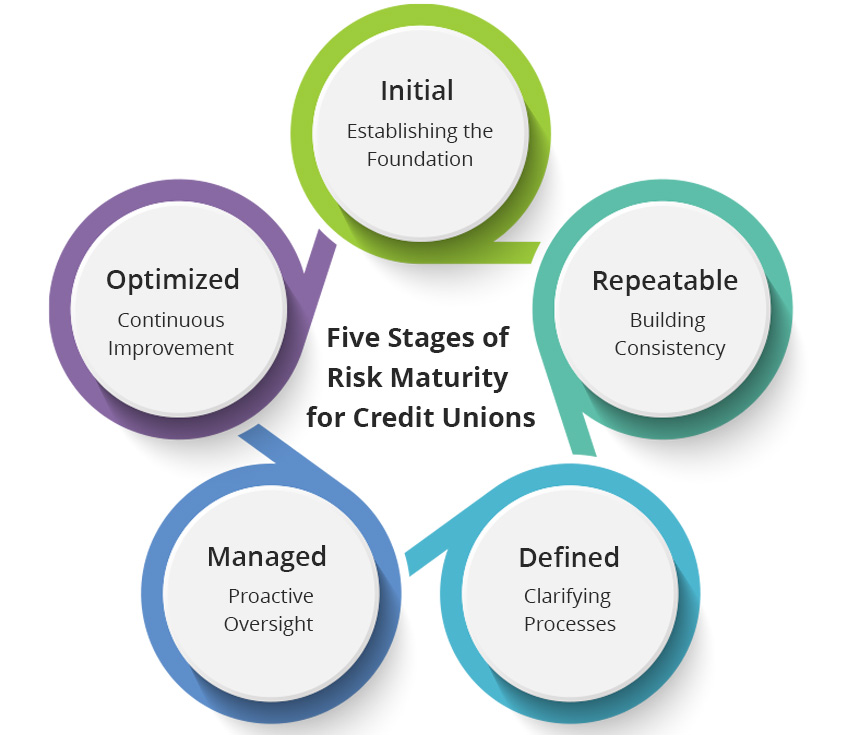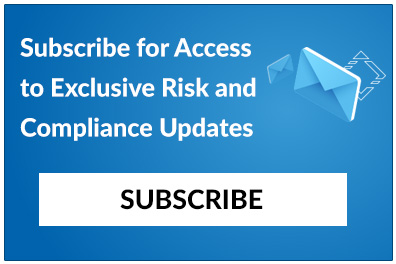Home/ Blog / From Reactive to Resilient: Achieving Risk Management Maturity in Credit Unions
Risk management for credit unions has evolved from a defensive necessity to a critical driver of growth, trust, and long-term resilience. This shift is significant. No longer is it enough to treat risk management as a routine compliance exercise, a check-the-box task to satisfy auditors and regulators. The growing complexity of risks, ranging from cybersecurity to regulatory pressures and market volatility, demands a more sophisticated and proactive approach.
A robust risk management program empowers credit unions to see beyond immediate risks and anticipate emerging challenges. It enables leadership to make informed, data-driven decisions that protect the organization and support sustainable growth and member confidence. When risk is embedded in day-to-day operations and linked to strategic goals, credit unions enhance their capacity to respond to disruptions, comply with evolving regulations, and maintain trust with members and stakeholders.
This blog examines how credit unions can advance along the risk maturity curve, transitioning from fragmented, manual processes to integrated, technology-driven strategies. With the right tools and frameworks, credit unions and community banks can effectively manage risk through real-time oversight, automation of routine tasks, and a culture that fosters shared responsibility for risk management across the organization.
The Hidden Cost of Staying Reactive
For many credit unions, risk management continues to rely heavily on spreadsheets, emails, and fragmented manual processes. While these tools may seem manageable in the short term, they create significant gaps and blind spots throughout the organization. Risk data becomes siloed, duplicated, or delayed, making it difficult to gain a clear, timely view of the organization’s risk exposure.
Without integrated systems, critical risks may go unnoticed until they escalate into significant issues. Missed or delayed responses to emerging risks can result in compliance breaches, financial losses, and significant reputational damage. Moreover, reactive risk management for credit unions consumes valuable time and resources, forcing teams to scramble in response to problems rather than preventing them.
As regulatory expectations rise and the risk landscape grows more complex, relying on outdated, manual approaches leaves credit unions vulnerable. Moving beyond reactive processes is crucial for building resilience, maintaining regulatory compliance, and safeguarding member trust.
The Five Stages of Risk Management Maturity for Credit Unions

Stage 1 – Initial
Risk management is reactive and fragmented for credit unions at the Initial stage of risk maturity. There are no structured processes or designated roles for overseeing risk, exposing the organization to blind spots and vulnerabilities. Risk activities are often driven by external audits or regulatory pressures rather than internal strategy. Manual tools, such as spreadsheets and emails, dominate, making it challenging to track risks and maintain audit readiness consistently. Without clear accountability, emerging risks can slip through the cracks, and any reporting is time-consuming, error-prone, and lacks depth. This results in ineffective risk management for credit unions.
Stage 2 – Repeatable
Credit unions and community banks see some progress in the repeatable stage of risk maturity. Specific departments, such as finance or IT, may conduct regular risk assessments, but these efforts remain siloed. Data is inconsistent, and processes vary significantly across functions, resulting in duplicated efforts and inefficiencies. Technology adoption remains minimal, with a continued reliance on spreadsheets and manual reporting. While pockets of good practice emerge, there’s no unified approach, making it difficult to scale or gain an enterprise-wide perspective. Risk remains largely operational rather than strategic, limiting its role in broader decision-making.
Stage 3 – Defined
This stage represents a significant milestone in risk management for credit unions. Risk processes are formalized at the departmental level, with more transparent frameworks and improved reporting capabilities. Some automation reduces manual workloads, and senior management actively engages in risk oversight. However, visibility across the enterprise remains limited. Departments manage risks independently, which still creates gaps in understanding the full organizational risk landscape. The organization gains better control and begins eliminating blind spots, but it still lacks a cohesive, enterprise-wide strategy that connects risk to overall performance and objectives.
Stage 4 – Managed
At the managed stage, credit unions achieve greater coordination and integration. The overall framework of risk management for credit unions is shared across functions, breaking down silos and enabling cross-departmental collaboration. Automation facilitates ongoing risk monitoring, allowing data to flow freely and enhancing efficiency and accuracy. Controls are in place and actively linked to performance indicators, enabling the organization to align risk management with its strategic goals. Reporting becomes more robust, offering leadership valuable insights across multiple risk categories. Audits are faster, and the organization begins to see tangible returns on its investment in risk management.
Stage 5 – Optimized
The optimized stage represents the peak of risk maturity. Here, risk management for credit unions is fully embedded into the organization’s culture and strategic planning. AI and advanced analytics provide real-time monitoring and predictive insights, allowing leaders to address risks before they escalate proactively. Continuous monitoring ensures that risk thresholds are maintained, and automated responses effectively mitigate emerging risks. The entire organization, from frontline staff to senior management, is aligned within a common risk management framework. With enterprise-wide visibility and a data-driven approach, the credit union can navigate uncertainties confidently, driving operational resilience and strategic growth.
How to Progress Up the Maturity Curve
Advancing along the risk maturity curve begins with an honest assessment of your credit union’s current position. Identifying your current risk stage — Initial, Repeatable, Defined, Managed, or Optimized — helps clarify your starting point and the gaps to close. From there, set clear, achievable goals that define success at the next maturity level and build a structured roadmap with milestones for effective risk management for credit unions.
Standardizing processes across departments is essential to eliminate silos and inconsistencies. Adopting smart, scalable tools will further streamline risk management, enabling automation, real-time monitoring, and better reporting. Equally important is fostering a strong risk culture from the top down. Involving leadership ensures that risk management in credit unions and community banks becomes a shared priority rather than an isolated function. When risk awareness permeates the organization, it empowers every team to proactively identify, manage, and mitigate risks, fostering long-term resilience.
Why Credit Unions Need AI-Based Software
Traditional risk management methods, such as spreadsheets, emails, and manual tracking, are no longer sufficient in today’s fast-paced and complex environment. These tools are inherently slow, error-prone, and disconnected, which makes it challenging to maintain an accurate, real-time view of risks. Emerging risks go unnoticed without timely insights until it’s too late, exposing credit unions to compliance failures, financial loss, and reputational damage.
AI-based risk management for credit unions transforms this outdated approach by centralizing all risk data on a single, integrated platform. Automation takes over routine tasks such as monitoring, alerts, and reporting, ensuring risks are identified and addressed proactively. Real-time visibility empowers leaders to make more informed decisions, and automated workflows streamline audits and regulatory reporting.
Accelerate Risk Maturity with Predict360 Essentials
For credit unions seeking to advance the risk maturity curve without incurring costly headcount, Predict360 Essentials provides an ideal solution. Designed explicitly for U.S. community banks and credit unions, this right-sized platform helps you efficiently modernize and streamline your risk management practices. As your organization progresses from reactive to proactive risk management, Predict360 Essentials supports every stage with intelligent automation, prebuilt tools, and real-time insights to help effective risk management for credit unions.
The platform features comprehensive, preloaded risk libraries and standardized credit union risk assessments encompassing critical areas, including BSA/AML, cybersecurity, UDAAP, vendor risk, fair lending, and other relevant areas. Instead of relying on scattered spreadsheets and manual tracking, Predict360 Essentials centralizes your risk data, automates routine tasks, and delivers dynamic dashboards for better visibility and oversight.
Request a Demo
Complete the form below and our business team will be in touch to schedule a product demo.
By clicking ‘SUBMIT’ you agree to our Privacy Policy.



